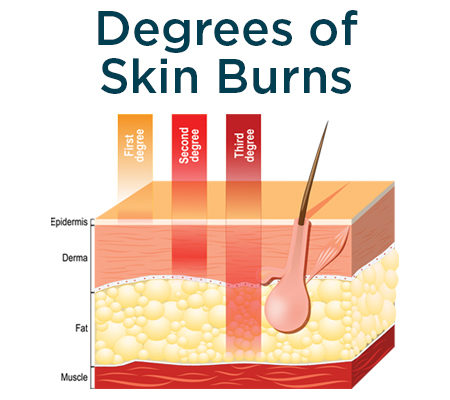You have probably heard burns explained as first-degree, second-degree or third-degree burns. The degree of the burn is a code for the depth of the burn in the tissue. For example, third-degree burns are deeper than first-degree burns and require different burn treatment.

“The description of a burn has evolved from discussion of degree to more accurately describing a burn based on depth of involvement,” said Dr. Elizabeth Helmer, burn medicine doctor, wound healing doctor and general surgeon at Marshfield Clinic Health System.
Depth is important because it determines how burns are treated. The ability of the skin to regenerate following a burn is dependent on structures within the deeper layer of the dermis called the reticular dermis. The dermis includes structures such as glands and hair follicles that allow skin to grow back. It is what gives skin its overall strength and elasticity.
Burns that are not deep are able to heal on their own because this layer is not involved. However, when a deep burn occurs, the reticular dermis is destroyed. These burns require special care.
Below are the five different depths of a burn and the treatments needed for each.
First-degree burn: Superficial burn
A first-degree burn, or a superficial burn, involves only the epidermis, or the outer layer of the skin. It can be red, blanching (turns white with pressure) and painful. It is similar to a non-blistering sunburn. This type of burn will generally heal within 3-4 days.
Second-degree burn: Superficial partial thickness burn
Superficial partial thickness burns, which are classified as a second-degree burn, involve the epidermis and the upper portion of the dermis called the papillary dermis.
This depth of burn may blister and is painful. Beneath the blister, the wound is pink/red, blanching and often has intact hair follicles.
“You should talk to a doctor if you have this type of burn because it can develop into deeper burns without adequate care,” Dr. Helmer said.
With appropriate burn treatment, these generally heal within 1-3 weeks.
Second-degree burn: Deep partial thickness burn
Deep partial thickness burns, which is a second-degree burn, involves the epidermis, papillary dermis and the deeper layer of the dermis called the reticular dermis.
A burn involving this level of the skin also can blister. However, beneath the blister the wound is a mixture of white/red with a more waxy appearance and is non-blanching. It may be painful or described as more of a pressure sensation.
You should talk to a doctor if you have these symptoms. For burn treatment for this type of burn, a doctor will need to remove the burned area and use skin grafting to grow skin. Deep partial thickness burns are not expected to heal within three weeks.
Third-degree burn: Full-thickness burn
This burn involves the entire dermis and is caused when the structures that allow for regeneration are destroyed.
In a third-degree burn, the underlying fat will be showing after the burned tissue is removed.
“At the time of injury, the skin will appear leathery or waxy with a gray or white color, or even charred,” Dr. Helmer said.
Full-thickness burns do not blanch and generally are not painful. A doctor will have to remove the burned skin and use skin grafting to grow the skin.
Fourth-degree burn: Beyond full-thickness burn
Burns that are beyond full-thickness are discovered at the time of removal of the burned tissue. These burns cause damage into structures under fat such as muscle and bone. These burns require extensive surgical treatment.
If you are concerned about a burn, go to your nearest emergency department.
For immediate care, visit Marshfield Clinic Health System.
Find an urgent care location Find an emergency department location
Related Shine365 articles
Fireworks safety tips: Keeping the show happy






Leave a Reply